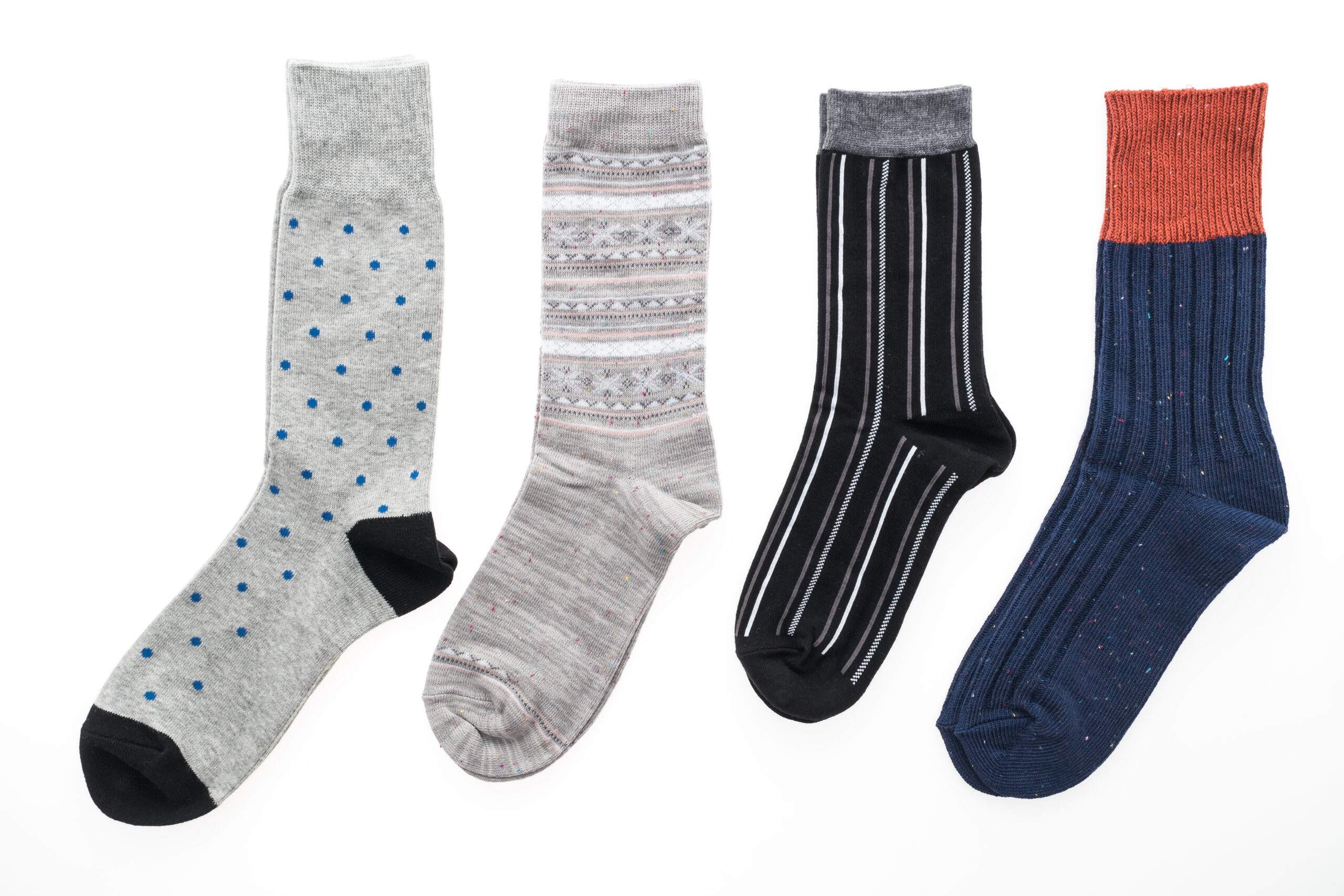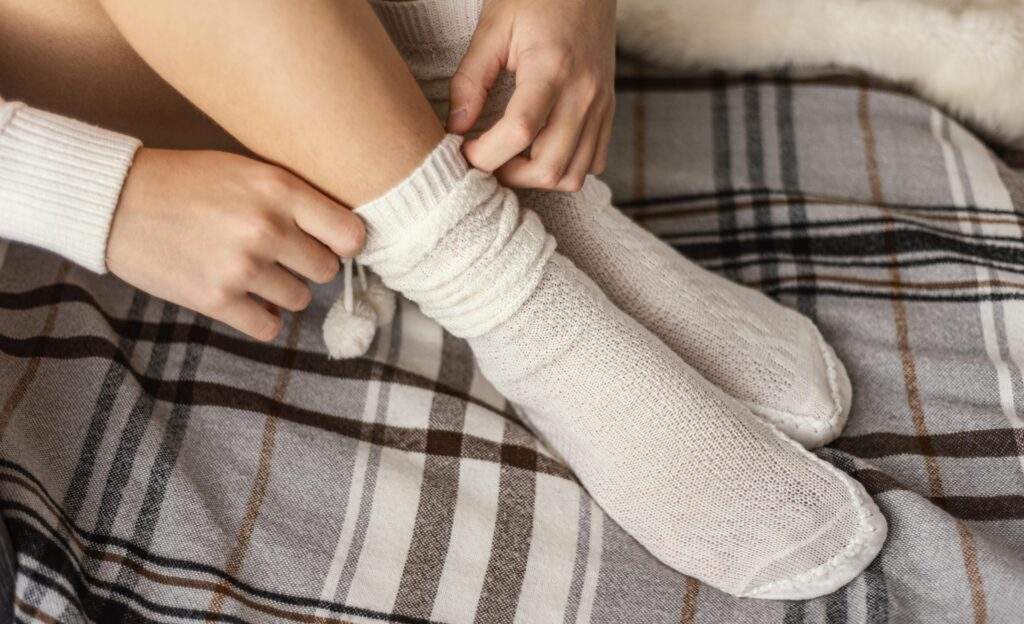A Deep Dive into the Best Sock Materials for Different Purposes
Choosing the sock material is crucial for ensuring optimal comfort and performance in various activities and occasions. While often overlooked, socks provide cushioning, moisture control, and temperature regulation for our feet. Understanding the sock materials available and their unique properties can help us make informed choices that enhance our overall experience.
When selecting sock materials, several factors come into play. Comfort is paramount because the material should feel soft against the skin and offer a pleasant wearing experience. Durability is another essential aspect, ensuring that your socks withstand frequent use and washing without losing shape or effectiveness. Moisture-wicking properties are crucial for preventing excessive sweat buildup and maintaining dryness, reducing the risk of blisters and discomfort. Additionally, insulation is vital, as different activities and weather conditions may require varying levels of heat retention or breathability.
By considering these factors and choosing the appropriate sock material, you can optimize your comfort, prevent foot-related issues, and enhance your overall performance in various activities like sports, outdoor adventures, or everyday wear. We will explore the best sock materials available and their suitability for different purposes, allowing you to make well-informed decisions.
Main yarns
Selecting the sock material is vital for maximum comfort and performance for many activities and occasions. The main yarn, which comprises the major components of the sock material, is a primary factor in determining the overall characteristics and quality of the socks. By familiarizing yourself with the unique properties of different materials and understanding how the proportion of each material affects the sock’s quality, you can make well-informed decisions that cater to your specific requirements.
Note that sock manufacturers frequently blend different materials to create socks with specific qualities. By comprehending the main yarn used in sock production and its associated attributes, you can select socks that align with your preferences and activities, guaranteeing optimal comfort and performance.

- Cotton Socks
Cotton is one of the most popular materials in sock production due to its comfort, breath-ability, and softness.
-
- Natural Fiber: Cotton is a natural fiber derived from the cotton plant, making it a widely available and cost-effective choice for sock manufacturing.
- Breathability: Cotton socks allow air to circulate the feet, promoting ventilation and preventing excessive sweat buildup. This breathability helps keep feet cool and dry during daily activities.
- Softness and Comfort: Cotton is known for its soft and gentle feel against the skin, providing a comfortable wearing experience throughout the day.
- Absorbency: Cotton has excellent moisture absorption properties, drawing sweat away from the skin. This absorption helps keep feet dry and reduces the risk of blisters and discomfort.
- Durability: Cotton socks are generally durable and can withstand regular use and washing without losing their shape or effectiveness.
- Everyday Wear: Cotton socks are ideal for everyday use and casual activities, providing a comfortable option for individuals looking for reliable and versatile sock choices.
- Limitations: While cotton socks offer many benefits, it’s important to note that they may retain moisture for long periods, especially during intense physical activities or in humid conditions. This moisture retention can lead to dampness, discomfort, and skin irritation.
- Blends and Reinforcements: Manufacturers often blend cotton with synthetic fibers like polyester or nylon to enhance the sock’s durability, moisture-wicking properties, and overall performance.
- Care Instructions: Cotton socks are generally machine washable and easy to maintain. However, follow the specific care instructions to ensure longevity.
- Availability: Cotton socks are widely available in various styles, colors, and thicknesses, making them easily accessible to consumers.
-
Combed Cotton Socks
Combed cotton is a variation of regular cotton that undergoes an additional process to remove shorter fibers and impurities, resulting in higher quality and more luxurious fabric.
-
- Superior Softness: The combing process removes shorter fibers and impurities, leaving longer and more uniform cotton fibers. It results in a softer and smoother texture compared to regular cotton socks.
- Enhanced Comfort: Combed cotton socks provide a luxurious feel against the skin, offering enhanced comfort throughout the day. The absence of shorter fibers minimizes any potential irritation or scratching sensation.
- Durability: Removing the short fibers during the combing produces more durable cotton yarn. Combed cotton socks are less prone to pilling and wear, maintaining their shape and quality over time.
- Breathability: Like regular cotton, combed cotton retains its natural breathability. It allows air circulation around the feet, preventing excessive sweating and promoting a cooler and drier environment.
- Moisture Absorption: Combed cotton socks possess excellent moisture absorption properties, effectively wicking away sweat from the skin. This absorption helps keep feet dry, reducing the likelihood of discomfort and blisters.
- Versatility: Combed cotton socks are versatile and suitable for various occasions, from casual everyday wear to more formal or dressy events. They provide both comfort and a polished appearance.
- Easy Maintenance: Combed cotton socks are generally machine washable and easy to care for. Following the manufacturer’s care instructions will help maintain their quality and longevity.
- Premium Option: Due to their higher quality and enhanced characteristics, combed cotton socks are often considered a premium choice. They may come at a slightly higher price than regular cotton socks, but the added benefits make them worth the investment for individuals seeking luxurious comfort.
-
Mercerized Cotton Socks
Mercerized cotton is a specially treated form that undergoes mercerization, which enhances its properties and appearance.
-
- Lustrous Appearance: Mercerization gives the cotton a glossy appearance and smooth finish, resulting in an attractive sheen on the fabric. This enhanced appearance adds a touch of elegance to the socks.
- Increased Strength: The mercerization process strengthens the cotton fibers, making them more resistant to wear and tear. Mercerized cotton socks are durable and withstand regular use and washing without losing their shape or quality.
- Enhanced Color Retention: Mercerized cotton has improved color absorption capabilities, allowing the socks to retain their vibrant colors even after repeated washes. It ensures that the socks maintain their aesthetic appeal over time.
- Breathability: Similar to regular cotton, mercerized cotton socks offer excellent breathability, allowing air to circulate the feet. It helps to keep the feet cool and comfortable, especially during warmer weather or prolonged wear.
- Softness and Comfort: Mercerized cotton socks retain the natural softness of cotton, providing a comfortable and gentle feel against the skin. They are smooth and pleasant to wear throughout the day.
- Moisture Absorption: Mercerized cotton possesses good moisture absorption properties, drawing sweat away from the skin and helping to keep the feet dry and fresh. This moisture-wicking capability contributes to overall comfort and prevents discomfort or blisters.
- Versatility: Mercerized cotton socks are versatile and suitable for various occasions. Whether for everyday wear, formal events, or casual outings, the lustrous appearance and comfort make them a stylish and practical choice.
- Easy Maintenance: Mercerized cotton socks are typically machine washable and easy to care for. Following the manufacturer’s care instructions will help maintain their quality and appearance.
-
Bamboo Socks
Bamboo is a popular and eco-friendly material used in the production of socks.

-
- Softness and Comfort: Bamboo fabric is exceptionally soft and gentle against the skin, providing a luxurious and comfortable wearing experience. It suits individuals with sensitive skin or those seeking a silky-smooth texture.
- Breathability: Bamboo socks are highly breathable, allowing air to circulate the feet. This natural ventilation helps regulate temperature, keeping your feet cool and dry even during extended wear.
- Moisture-Wicking: Bamboo fabric has excellent moisture absorption and wicking capabilities. It can effectively pull moisture away from the skin, keeping your feet dry and preventing sweat. It helps reduce the risk of blisters, odors, and discomfort.
- Anti-Odor and Antibacterial: Bamboo contains a natural antimicrobial agent called bamboo kun, which helps inhibit the growth of bacteria and prevents unpleasant odors. As a result, bamboo socks tend to stay fresh for long periods and require fewer washes.
- Hypoallergenic: Bamboo fabric is hypoallergenic, making it an ideal choice for individuals with allergies or sensitive skin. It is less likely to cause irritation or allergic reactions than other materials.
- Environmental Sustainability: Bamboo is a highly sustainable material due to its rapid growth and minimal impact. It requires no pesticides or chemicals, making it a more eco-friendly alternative to traditional sock materials.
- UV Protection: Bamboo fabric naturally protects against harmful UV rays, making bamboo socks an option for outdoor activities or when exposed to sunlight.
- Durability: Despite its softness, bamboo fabric is surprisingly durable. Bamboo socks can withstand regular wear and washing without losing shape or effectiveness.
- Thermal Regulation: Bamboo socks possess excellent temperature-regulating properties. They keep your feet cool in hot weather and provide insulation in colder conditions.
- Biodegradable: Bamboo decomposes on its own without harming nature. It makes bamboo socks a more sustainable choice compared to synthetic alternatives.
-
Modal Socks
Modal is a type of rayon fabric made from the cellulose fibers of beech trees.
-
- Softness and Smoothness: Modal fabric is known for its incredibly soft and silky texture. Socks made from modal provide a luxurious and comfortable feel against the skin, offering a gentle and smooth touch.
- Moisture Absorption: Modal has excellent moisture absorption properties, absorbing moisture from the skin and wicking it away. It helps keep your feet dry and prevents discomfort caused by excessive sweating.
- Breathability: Modal socks allow air to circulate the feet, promoting breathability and ventilation. It helps regulate foot temperature and prevents moisture buildup, reducing the risk of odor and blisters.
- Lightweight and Drape: Modal fabric is lightweight and has a beautiful drape, allowing socks to conform to the shape of your feet for a snug fit. It adds to the overall comfort and flexibility of modal socks.
- Resistance to Shrinkage and Pilling: Modal is less prone to shrinkage and pilling than other materials. Modal socks retain their shape well and maintain their smooth appearance even after repeated washing and wear.
- Durability: Despite its lightweight nature, the modal fabric is known for its durability. Modal socks are sturdy and long-lasting, ensuring they can withstand regular use without losing their quality.
- Color Retention: Modal has excellent color retention properties, meaning the vibrant colors of modal socks will stay true even after multiple washes. It ensures that your socks remain visually appealing over time.
- Thermal Regulation: Modal fabric offers good thermal regulation, helping to keep your feet comfortable in various weather conditions. It keeps your feet cool in warm weather and provides insulation in colder temperatures.
- Resistance to Wrinkles: Modal fabric has a natural resistance to wrinkles, so modal socks maintain their smooth appearance even after being stored or folded for extended periods.
- Eco-Friendliness: Modal is derived from sustainable beech trees, making it an eco-friendly choice for socks. The production process of modal also requires less water and energy than other textile fibers.
-
Merino Wool Socks
Merino wool is a high-quality natural fiber derived from Merino sheep.
-
- Softness and Comfort: Merino wool is incredibly soft and thin, providing a luxurious and comfortable feel against the skin. Unlike traditional wool, it is not itchy or scratchy, making it suitable for sensitive skin.
- Moisture-Wicking: Merino wool has excellent moisture-wicking properties. It can absorb and release moisture vapor from the skin. It can absorb up to 30% of its weight in moisture without feeling wet, keeping your feet dry and preventing discomfort caused by sweat.
- Temperature Regulation: Merino wool acts as a natural insulator, helping to regulate body temperature. It keeps your feet warm in cold weather by trapping air and providing insulation. It also allows heat to escape when it’s hot, keeping your feet cool.
- Odor Resistance: Merino wool has natural antibacterial properties that help prevent the growth of odor-causing bacteria. Merino wool socks tend to stay fresher longer, even after extended use.
- Breathability: Merino wool fibers have a natural crimp that creates tiny air pockets within the fabric. It allows for enhanced breathability, allowing air to circulate your feet and preventing excessive sweating.
- Softness and Durability: Despite its softness, merino wool is highly durable and long-lasting. Merino wool socks can withstand regular use and maintain their shape and quality over time.
- Lightweight and Moisture Management: Merino wool is lightweight and can regulate moisture. It can keep your feet dry even in humid conditions. It helps prevent moisture buildup, reducing the risk of blisters and discomfort.
- UV Protection: Merino wool provides natural UV protection, shielding your feet from harmful sun rays during outdoor activities.
- All-Season Performance: Merino wool socks are versatile and suitable for all seasons. They provide warmth in winter and regulate temperature in summer, making them ideal for many activities and weather conditions.
- Sustainability: Merino wool is a renewable and biodegradable material. It comes from a sustainable source, as we can shear them annually without causing harm to the sheep.
-
Viscose Rayon Socks
Viscose rayon, or artificial silk, is a regenerated cellulose fiber derived from natural sources such as wood pulp or bamboo.
-
- Softness and Smoothness: Viscose rayon socks have a soft and smooth texture, providing a comfortable and gentle feel against the skin. They offer a luxurious touch similar to silk.
- Breathability: Viscose rayon is highly breathable, allowing air to circulate through the feet. It helps regulate foot temperature, keeping your feet cool and comfortable, particularly in warm weather or during physical activities.
- Moisture Absorption: Viscose rayon has good moisture absorption properties, wicking away moisture from the skin and keeping your feet dry. It helps to prevent the buildup of sweat and reduces the likelihood of discomfort or blisters.
- Lightweight: Viscose rayon is a lightweight material, making socks from this fabric comfortable to wear without feeling bulky or heavy.
- Drapability: Viscose rayon has excellent drapability, allowing socks to conform to the shape of your feet for a snug fit. It enhances overall comfort and flexibility.
- Versatility: Viscose rayon socks are versatile and suitable for various occasions. They can be worn for everyday activities, formal events, or casual outings, offering a blend of comfort and style.
- Color Vibrancy: Viscose rayon has good color retention, meaning the vibrant colors of socks made from this material remain intact even after repeated washes. It ensures that your socks retain their visual appeal over time.
- Affordability: Viscose rayon socks are more affordable than certain natural fibers like merino wool or bamboo. They provide a cost-effective option for individuals seeking comfortable socks without breaking the bank.
- Easy Care: Viscose rayon socks are generally easy to care for and maintain. They can be machine washed, but follow the manufacturer’s care instructions to preserve their quality and lifespan.
-
Polyester Socks
Polyester is a synthetic fiber commonly used in sock production due to its durability and performance characteristics.

-
- Durability: Polyester is known for its strength and resistance to stretching, making it highly durable. Polyester socks can withstand frequent use and washing without losing shape or quality.
- Moisture Wicking: Polyester has excellent moisture-wicking properties, meaning it can effectively draw moisture away from the skin and towards the surface. It helps to keep your feet dry and comfortable by reducing sweat buildup.
- Quick Drying: Polyester has a fast drying time, allowing socks to dry quickly after washing or in wet conditions. This feature is particularly advantageous for individuals engaged in sports or outdoor activities.
- Wrinkle Resistance: Polyester fabric is resistant to wrinkles and creases, ensuring that polyester socks maintain a smooth and neat appearance even after being stored or folded.
- Colorfastness: Polyester has good colorfastness, meaning that polyester socks retain their vibrant colors even after multiple washes. It ensures that the socks maintain their visual appeal over time.
- Easy Care: Polyester socks are easy to care for and require minimal maintenance. They are generally machine washable and dry quickly, making them convenient for everyday use.
- Breathability (with Blended Fabrics): While polyester is not as breathable as natural fibers when blended with other materials such as cotton or bamboo, it can enhance the breathability of the socks. Polyester blends can provide a balance between durability and breathability.
- Resistant to Mildew and Moths: Polyester is naturally resistant to mildew, making it less susceptible to odors caused by fungal growth. It is also moth-resistant, making polyester socks a good option for long-term storage.
- Shape Retention: Polyester has excellent shape retention properties, meaning that socks maintain their form even after repeated use and washing. They are less prone to stretching or sagging over time.
- Affordability: Polyester socks are often more affordable than natural fibers. They provide a cost-effective option for individuals seeking durable and functional socks on a budget.
-
Nylon Socks
Nylon is a synthetic fiber widely used in the production of socks.
-
- Durability: Nylon is known for its exceptional strength and durability, making nylon socks highly resistant to wear and tear. They can withstand rigorous use, making them suitable for athletic activities or high-impact sports.
- Moisture Wicking: Nylon has excellent moisture-wicking properties, meaning it can effectively draw moisture away from the skin. It helps to keep your feet dry by reducing sweat buildup and preventing discomfort.
- Quick Drying: Nylon fabric dries quickly, making nylon socks ideal for intense physical exertion or exposure to wet conditions. The fast drying time ensures that your socks remain comfortable and ready for use in a short amount of time.
- Lightweight: Nylon is a lightweight material, which adds to overall comfort and flexibility. These provide a snug fit without feeling bulky or heavy on the feet.
- Breathability: While nylon is not as breathable as natural fibers, it offers moderate breathability. Nylon socks allow airflow to circulate the feet, helping to regulate temperature and prevent excessive sweating.
- Shape Retention: Nylon has excellent shape retention properties, meaning socks maintain their form even after repeated use and washing. They are less prone to stretching or sagging over time.
- Elasticity: Nylon has good elasticity, allowing nylon socks to stretch and conform to the shape of your feet. It ensures a secure and comfortable fit, preventing the socks from slipping or bunching up.
- Resistance to Wrinkles: Nylon fabric is resistant to wrinkles, ensuring that nylon socks maintain a smooth and neat appearance even after being stored or folded.
- Easy Care: Nylon socks are easy to care for and require minimal maintenance. They can be machine washed and dried without the need for special handling.
- Affordability: Nylon socks are often more affordable than natural fibers. They provide a cost-effective option for individuals seeking durable and functional socks.
-
Acrylic Socks
Acrylic is a synthetic fiber commonly used in sock production due to its unique properties.
-
- Softness and Comfort: Acrylic socks have a soft and cozy feel, providing comfort and warmth for your feet. The fibers are smooth and gentle against the skin, making them suitable for individuals with sensitive skin.
- Moisture Wicking: Acrylic has moisture-wicking properties, meaning it can effectively absorb moisture from the skin and move it to the surface, where it can evaporate. It helps to keep your feet dry and prevents discomfort caused by sweat.
- Quick Drying: Acrylic fabric has a fast drying time, allowing socks to dry quickly after washing or in wet conditions. This feature is particularly beneficial for individuals engaged in outdoor activities or sports.
- Lightweight: Acrylic is a lightweight material, making acrylic socks comfortable to wear without feeling bulky or heavy on the feet. It enhances flexibility and freedom of movement.
- Thermal Insulation: Acrylic fibers provide excellent thermal insulation, helping to keep your feet warm in cold weather. They trap air within the fabric, creating a layer of warmth around your feet.
- Colorfastness: Acrylic has good color retention properties, meaning that acrylic socks retain their vibrant colors even after repeated washes. It ensures that the socks maintain their visual appeal over time.
- Durability: Acrylic socks are known for their durability and resistance to wear and tear. They can withstand regular use and maintain their shape and quality over extended periods.
- Resistance to Shrinkage: Acrylic is less prone to shrinkage than other materials, ensuring that your socks retain their original size and fit even after washing.
- Easy Care: Acrylic socks are easy to care for and maintain. They can be machine washed and dried without special handling or additional care instructions.
- Affordability: Acrylic socks are often more affordable than natural fibers. They provide a cost-effective option for individuals seeking soft and comfortable socks at a reasonable price.
-
Polypropylene Socks
Polypropylene is a synthetic fiber widely used for socks, especially in outdoor activities and sports such as hiking, running, and skiing, where moisture management and insulation are crucial.
-
- Moisture Wicking: Polypropylene has excellent moisture-wicking properties, meaning it can effectively draw moisture away from the skin. It helps to keep your feet dry and prevents discomfort caused by sweat buildup.
- Quick Drying: Polypropylene fabric has a rapid drying time, making polypropylene socks ideal for intense physical exertion or exposure to wet conditions. The fast-drying capability ensures that your socks remain comfortable and ready for use in a short amount of time.
- Lightweight: Polypropylene is an extremely light material, which adds to the overall comfort and flexibility of polypropylene socks. They provide a snug fit without adding extra bulk or weight.
- Insulation: Polypropylene offers good insulation properties, helping to keep your feet warm in cold weather conditions. It helps to retain body heat and provides a layer of warmth around your feet.
- Breathability: Polypropylene socks are highly breathable, allowing air to circulate on your feet. It helps to regulate foot temperature and prevent excessive sweating.
- Odor Resistance: Polypropylene has inherent odor resistance properties, making polypropylene socks less likely to develop unpleasant odors. It helps to inhibit the growth of odor-causing bacteria, keeping your feet fresh even during prolonged wear.
- Durability: Polypropylene is known for its durability and resistance to wear and tear. The material can withstand frequent use and maintain its shape and quality over time.
- Resistant to Stains: Polypropylene is resistant to staining, making it easier to keep polypropylene socks clean and free from discoloration.
- Allergen-Free: Polypropylene is hypoallergenic and non-irritating to the skin, making it a suitable choice for individuals with sensitive skin or allergies.
- Compatibility with Layering: Polypropylene socks work well as a base layer in a multi-layer sock system. They effectively wick moisture away from the skin, helping to keep your feet dry and comfortable when layered with other socks.
-
Tencel (Lyocell) Socks
Tencel, or Lyocell, is a sustainable and eco-friendly fiber derived from wood pulp.
-
- Softness and Comfort: Tencel fibers are known for their exceptional softness, providing a luxurious and gentle feel against the skin. Socks made from Tencel are incredibly comfortable, even for individuals with sensitive skin.
- Moisture Absorption and Wicking: Tencel has excellent moisture absorption properties, making it highly effective at wicking away moisture from the skin. It helps to keep your feet dry and comfortable, preventing sweat and reducing the risk of blisters.
- Breathability: Tencel fibers are highly breathable, allowing air to circulate on your feet. It enhances ventilation and helps regulate foot temperature, keeping your feet cool and dry.
- Hypoallergenic: Tencel is naturally hypoallergenic and less likely to cause skin irritations or allergies. It suits individuals with sensitive skin or allergies to other synthetic fibers.
- Sustainability: Tencel is derived from sustainably sourced wood pulp, making it an environmentally friendly choice. The production process of Tencel utilizes a closed-loop system, where the solvents used are recycled, minimizing waste and environmental impact.
- Biodegradable: Tencel is biodegradable. It can naturally break down over time, reducing its ecological footprint.
- Strength and Durability: Tencel fibers are sturdy and durable despite their softness. Socks made from Tencel have good resistance to wear and tear, ensuring long-lasting performance.
- Enhanced Color Retention: Tencel has excellent color retention properties, meaning socks maintain their vibrant colors even after multiple washes. It helps to preserve the visual appeal of the socks over time.
- Thermal Regulation: Tencel offers good thermal regulation, keeping your feet cool in warm weather and providing insulation in colder conditions. It helps to maintain a comfortable foot temperature throughout various activities.
- Antimicrobial Properties: Tencel has inherent antimicrobial properties, inhibiting the growth of bacteria and reducing odor formation. It makes Tencel socks an ideal choice for individuals seeking freshness and odor control.
- Auxiliary or supplemental, or reinforcement yarn: It is used alongside the main fabric to provide specific functional or structural attributes to the material.
Auxiliary yarns serve different purposes depending on their characteristics and the intended application of the fabric.
-
- Elastic Yarn: Elastic yarns, such as spandex or Lycra, are often used as auxiliary yarns to add stretch and elasticity to socks. They enhance the sock’s ability to conform to the shape of the foot, providing a snug and comfortable fit.
- Reinforcement Yarn: Reinforcement yarns, typically made of sturdy fibers like nylon or polyester, are used to reinforce specific areas of the sock that experience higher wear or stress, such as the heel, toe, or sole. They enhance durability and prevent premature wear and tear.
- Lurex Yarn: Lurex is a type of metallic yarn that adds a decorative and shimmering effect to socks. It is often used as an auxiliary yarn to create patterns or add a touch of sparkle to the design.
- Antibacterial or Odor-Resistant Yarn: Some yarns are treated with antibacterial agents or contain fibers with inherent odor-resistant properties. These yarns help combat the growth of bacteria or fungi, reducing odor formation and promoting freshness in socks.
Over to You
Choosing suitable materials is essential for optimal comfort, performance, and durability in various activities and occasions. Each sock material offers unique properties that cater to different needs and preferences. By understanding the characteristics of these materials and their proportions in sock production, you can make informed decisions that align with your specific requirements.
Ignite is your trusted partner when sourcing high-quality socks for your business, event, or other endeavors from China. With a wide range of socks crafted from premium materials, Ignite offers the perfect combination of comfort, functionality, and style. Whether you’re looking for socks to promote your brand, outfit your team, or create event merchandise, Ignite has you covered.
You access our expertise in sock sourcing and customization by connecting with Ignite. We understand the importance of delivering socks that meet your unique needs, ensuring superior quality, design, and branding. With Ignite’s reliable and efficient service, you can elevate your brand image, enhance customer satisfaction, and make a lasting impression.
Don’t settle for ordinary socks when you can elevate your sock game with Ignite. Whether you’re a large corporation or a small business, Ignite has the expertise and resources to deliver top-notch socks tailored to your specifications.
FAQs:
- Which sock material is best?
The best sock material depends upon the purpose. For example, polyester is helpful for athletic socks.
- What is the most durable material for socks?
Nylon is generally considered the most durable fabric for socks due to its strength and resistance to wear and tear.
- What are the most comfortable socks made of?
Socks made of merino wool or bamboo fibers are the most comfortable. They offer softness, breathability, moisture-wicking properties, and temperature regulation, providing a comfortable experience for the wearer.
- How do I choose quality socks?
When choosing quality socks, consider material, construction, cushioning, moisture-wicking properties, and proper fit. Look for reputable brands known for their attention to detail and use of high-quality materials.
- Is cotton or wool better for socks?
Cotton and wool have different characteristics, and the choice depends on your specific needs. Cotton socks are breathable, lightweight, and suitable for everyday use in moderate climates. Wool socks, particularly those made of merino wool, offer superior insulation, moisture-wicking properties, and odor control, making them ideal for colder climates and outdoor activities.
- What are cheap socks made of?
Cheap socks use synthetic materials like polyester or acrylic. These materials are cost-effective but may not offer the same comfort, breathability, or durability as natural fibers like cotton or wool.
- Are polyester socks better than cotton?
Polyester socks offer better moisture-wicking and durability, while cotton socks provide comfort and breathability.



